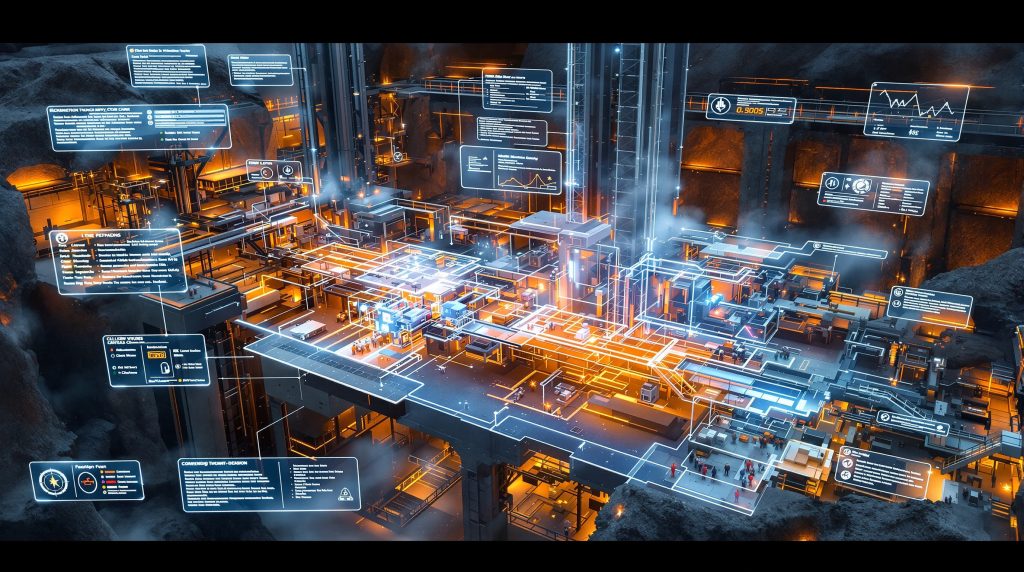Engineering Marvel: How Deep Modern Mining Operations Can Reach
Modern mining operations have pushed the boundaries of what engineers thought possible, with some facilities now extending more than two kilometers beneath Earth's surface. The completion of Resolution Copper shaft deepening in Arizona represents a watershed moment in ultra-deep mining infrastructure, demonstrating both the technical complexity and massive financial investment required for these extreme engineering projects.
Contemporary deep mining operations face unprecedented challenges as they venture into depths equivalent to stacking multiple skyscrapers underground. These projects require specialized equipment, advanced safety protocols, and innovative construction techniques that push the limits of current mining industry evolution.
What Defines Ultra-Deep Mining in Today's Industry
The Resolution Copper No. 9 Shaft project provides a benchmark for understanding what constitutes truly deep mining infrastructure. At 2,103 meters below surface, this facility represents the equivalent depth of nearly five Empire State Buildings stacked vertically underground. The shaft maintains a consistent 6.7-meter diameter throughout its entire depth, demonstrating the engineering precision required for ultra-deep operations.
Industry classification systems typically categorize mines exceeding 1,500 meters as deep operations, while those surpassing 2,000 meters enter ultra-deep territory. The Resolution Copper facility ranks as the second-deepest single-lift mine shaft in the United States, exceeded only by the company's adjacent No. 10 Shaft at 2,118 meters.
Depth Classification Standards:
• Surface operations: 0-200 meters depth
• Shallow underground: 200-500 meters
• Deep operations: 500-1,500 meters
• Ultra-deep mining: 1,500+ meters
• Extreme depth operations: 2,000+ meters
The technical distinction between single-lift and multi-stage systems becomes critical at these depths. Single-lift shafts, like the Resolution Copper installations, provide direct vertical access from surface to maximum depth without intermediate staging areas. This design maximizes operational efficiency but requires exceptional structural engineering to manage the extreme loads and environmental conditions encountered at depth.
Furthermore, the dual-shaft configuration at Resolution Copper illustrates modern approaches to ultra-deep mining infrastructure. The No. 9 and No. 10 Shafts operate as an integrated system, with one serving primarily for ventilation and emergency access while the other handles material transport and personnel movement.
Engineering Challenges at Extreme Depths
Ultra-deep mining operations encounter environmental conditions that challenge conventional construction and operational methods. The Resolution Copper shaft deepening project exemplifies these technical complexities through its construction requirements and safety achievements.
Construction Scale and Material Requirements:
The magnitude of materials required for the Resolution Copper project demonstrates the engineering complexity of ultra-deep construction:
• 4,420 meters of specialized drilling through hard rock formations
• 430 cubic meters of concrete placement in confined vertical spaces
• 128 cubic meters of shotcrete application for immediate rock stabilization
• Two-year construction timeline with zero recordable injuries
Temperature and Pressure Management:
While specific thermal data for the Arizona site was not disclosed, ultra-deep operations typically encounter geothermal gradients that increase temperatures by 25-30 degrees Celsius per kilometer of depth. At 2,103 meters, this suggests working temperatures potentially exceeding 50-60 degrees Celsius without climate control systems.
The structural loads imposed by surrounding rock formations at this depth require sophisticated shaft lining systems and continuous monitoring for ground movement or pressure changes. Consequently, the successful completion of drilling operations spanning 4.4 kilometers indicates the project successfully managed these extreme conditions.
Advanced Safety Protocols:
The Resolution Copper project achieved an exceptional safety record during construction operations. Operations Manager Rob Tobin noted the significance of completing more than two years of underground work without any recordable injuries, stating this performance demonstrates the professionalism required to bring legacy infrastructure back to modern operational standards.
This safety achievement becomes particularly remarkable considering the challenging working environment: crews operated in confined spaces more than two kilometers underground while conducting precision drilling, concrete placement, and shotcrete application operations.
The Economics Behind $200 Million Infrastructure Investments
Resolution Copper's shaft deepening project required a $200 million investment to extend the No. 9 Shaft by 640 meters, from its original 1,463-meter depth to the final 2,103-meter operational depth. This investment translates to approximately $312,500 per meter of additional shaft depth, illustrating the premium costs associated with ultra-deep mining infrastructure.
Project Investment Breakdown:
| Investment Component | Specification |
|---|---|
| Total Project Cost | $200 million |
| Depth Extension | 640 meters |
| Cost Per Meter | $312,500 |
| Construction Duration | 2 years |
| Shaft Diameter | 6.7 meters |
| Drilling Volume | 4,420 meters |
Specialized Contractor Requirements:
The project required coordination between multiple specialized contractors, each bringing specific expertise to ultra-deep construction challenges. For instance, Redpath USA led shaft sinking and primary construction operations, working alongside Oddonetto Construction for concrete placement and logistics coordination.
Infrastructure Modernization Costs:
The rehabilitation aspect of this project added significant complexity and cost. The original shaft, constructed by Magma Copper Company in 1971 and operational until the mid-1990s, required complete modernization to meet contemporary safety and operational standards. This modernization encompassed electrical systems, ventilation networks, emergency egress routes, and structural reinforcement.
President and General Manager Vicky Peacey emphasized the strategic nature of this investment, noting that the completed infrastructure enables access to one of North America's largest undeveloped copper deposits. However, the $200 million expenditure represents foundational investment in domestic mineral security and rural economic development for Arizona.
Case Study: Resolution Copper's Historic Achievement
The Resolution Copper shaft deepening project represents one of the most significant ultra-deep mining infrastructure achievements in recent North American mining history. This case study provides detailed analysis of the technical specifications, financial investment, and operational outcomes of a major shaft deepening operation.
Resolution Copper Project Specifications:
| Project Element | Specification |
|---|---|
| Location | Arizona, USA |
| Original Construction | 1971 (Magma Copper Company) |
| Original Depth | 1,463 meters |
| Final Depth | 2,103 meters |
| Depth Extension | 640 meters |
| Shaft Diameter | 6.7 meters |
| Total Investment | $200 million |
| Construction Period | 2 years (completed November 2025) |
| US Depth Ranking | Second-deepest single-lift shaft |
| Operational Function | Ventilation and access for mining complex |
Operational Integration:
The No. 9 Shaft operates in conjunction with Resolution Copper's No. 10 Shaft, which extends to 2,118 meters and holds the distinction of being the deepest single-lift mine shaft in the United States. Furthermore, these installations form an integrated dual-shaft system that provides redundant access, ventilation circulation, and emergency egress capabilities for the underground mining operation.
In addition, the shaft rehabilitation transformed a decommissioned 1970s-era production shaft into a modern ventilation and access facility. This conversion required complete infrastructure modernization while extending the depth by more than 40% from its original specifications.
Construction Achievement Metrics:
The project's construction metrics demonstrate the scale and precision required for ultra-deep mining infrastructure. These achievements showcase how modern drilling program types have evolved to meet extreme operational demands.
Safety Excellence in Ultra-Deep Construction
The Resolution Copper No. 9 Shaft project achieved a remarkable safety milestone by completing 730 consecutive days without recordable injuries during active construction operations. This performance occurred while crews worked more than two kilometers underground in challenging conditions involving precision drilling, concrete placement, and rock stabilization activities.
Safety Performance Metrics:
| Safety Indicator | Achievement |
|---|---|
| Construction Duration | 730+ days |
| Recordable Injuries | Zero |
| Lost-Time Incidents | Zero |
| Medical Injuries | Zero |
| Working Environment | 2,103 meters below surface |
| Construction Activities | Drilling, concrete placement, shotcrete application |
Risk Management in Extreme Environments:
Operations Manager Rob Tobin attributed the safety achievement to the professionalism and dedication of underground crews working to modernise the historic shaft infrastructure. The zero-injury performance becomes particularly significant considering the inherent risks associated with drilling operations in confined vertical spaces and equipment operation in high-stress underground environments.
The achievement of over 730 consecutive days without recordable injuries during ultra-deep shaft construction represents industry-leading safety performance that sets new benchmarks for extreme-depth mining operations.
Emergency Response and Risk Mitigation:
Ultra-deep mining operations require sophisticated emergency response capabilities due to the challenges of evacuating personnel from depths exceeding two kilometers. The Resolution Copper dual-shaft system provides redundant emergency egress routes, with both the No. 9 and No. 10 Shafts serving emergency evacuation functions.
Technical Infrastructure for Ultra-Deep Operations
The Resolution Copper shaft complex demonstrates the sophisticated infrastructure required for ultra-deep mining operations. The 6.7-meter diameter specification represents industry-standard sizing for major mining shafts, providing sufficient space for personnel transport, material handling, and ventilation systems while maintaining structural integrity at extreme depths.
Shaft Design and Capacity:
The dual-shaft configuration provides operational redundancy and enhanced capacity through integrated design principles that support data-driven operations throughout the facility.
Ventilation Engineering:
Ultra-deep mining operations require sophisticated ventilation systems to manage air quality, temperature control, and atmospheric pressure at extreme depths. The dual-shaft design enables continuous air circulation through the underground workings, with fresh air intake through one shaft and exhaust ventilation through the parallel installation.
Material Transport Specifications:
The 6.7-meter diameter provides adequate capacity for modern mining equipment and material transport systems. This sizing accommodates high-capacity personnel transport systems, heavy equipment movement for underground development, and emergency evacuation equipment and procedures.
Economic Development and Strategic Resource Access
Resolution Copper's $200 million infrastructure investment represents more than mining facility development; it establishes access to critical mineral resources essential for national security and economic development. President and General Manager Vicky Peacey emphasized that the project enables access to one of North America's largest undeveloped copper deposits.
Regional Economic Impact:
The ultra-deep mining infrastructure development generates significant economic benefits for rural Arizona. These benefits include direct employment creating thousands of high-paying mining and construction jobs, economic development generating billions in regional economic activity, and supply chain benefits supporting specialized contractors and equipment suppliers.
Domestic Mineral Security:
The Resolution Copper shaft deepening addresses strategic concerns about domestic mineral supply security. Copper represents a critical material for electrical infrastructure, renewable energy installations, transportation electrification, and modern communication networks.
Future Technology Integration and Automation
Ultra-deep mining operations increasingly incorporate advanced technology systems to manage the complexities of extreme-depth environments. The Resolution Copper infrastructure provides a platform for implementing cutting-edge mining technologies as they become available, including AI in drilling and blasting operations.
Automation Potential:
The shaft specifications and integrated design support future automation initiatives through automated material transport systems, remote monitoring capabilities, predictive maintenance systems, and environmental controls that optimise operational efficiency.
Digital Infrastructure:
Modern ultra-deep mining operations require sophisticated communication and data systems to coordinate activities across extreme depths. The shaft infrastructure provides pathways for high-speed data transmission, real-time monitoring, emergency communication systems, and integrated operational control systems.
Regulatory Framework and Development Challenges
Ultra-deep mining projects operate within complex regulatory environments that address safety, environmental protection, and community impacts. The Resolution Copper shaft deepening project faces ongoing litigation that has delayed full project development despite completion of the $200 million infrastructure investment.
Permitting Complexity:
Ultra-deep mining operations require extensive regulatory approvals including environmental impact assessments, safety standard compliance, community consultation, and ongoing monitoring obligations. These requirements necessitate modern mine planning approaches that integrate regulatory compliance throughout project development.
Legal and Development Challenges:
President Vicky Peacey acknowledged that ongoing litigation continues to delay project development despite infrastructure readiness. However, this situation illustrates common challenges facing major mining developments including stakeholder opposition, regulatory approval timelines, and legal challenge management.
Determining Ultimate Depth Limits for Mining Operations
The Resolution Copper project at 2,103 meters approaches the practical depth limits of current mining technology, though these boundaries continue to expand with advancing engineering capabilities. Several factors determine the ultimate feasible depth for mining operations.
Geological Constraints:
Physical limitations imposed by Earth's geology become increasingly challenging at extreme depths. These include rock pressure from overlying formations, ground stability concerns, groundwater management challenges, and geothermal gradients that affect equipment and worker safety.
Economic Viability Thresholds:
The Resolution Copper project's $200 million cost for 640 meters of deepening illustrates the economic challenges of ultra-deep development. Consequently, cost escalation, resource grade requirements, technology investment, and market price sensitivity all influence project viability assessments.
The Future of Ultra-Deep Mining Infrastructure
The completion of Resolution Copper's $200 million shaft deepening project represents a significant milestone in ultra-deep mining infrastructure development. This achievement demonstrates that contemporary engineering capabilities can successfully overcome the extreme technical challenges associated with mining at depths exceeding two kilometres below surface.
The project's exceptional safety record, with zero recordable injuries over 730 days of construction operations, establishes new benchmarks for ultra-deep mining safety performance. Furthermore, this achievement reflects the successful integration of modern safety protocols, advanced construction techniques, and professional workforce development in extreme underground environments.
Strategic Infrastructure Investment:
The $200 million investment in shaft deepening infrastructure provides decades of access to critical mineral resources essential for national security and economic development. The project enables domestic copper production from one of North America's largest undeveloped deposits, reducing dependence on mineral imports while supporting regional economic development in rural Arizona.
Industry Development Implications:
The successful completion of the Resolution Copper shaft project demonstrates the viability of ultra-deep mining infrastructure investments. As global demand for critical minerals continues expanding, similar projects will become increasingly important for accessing previously uneconomical ore bodies located at extreme depths.
In addition, the technical expertise and safety protocols developed through this project will influence industry standards for future ultra-deep mining developments worldwide. The integration of modern construction techniques with legacy infrastructure rehabilitation provides valuable insights for similar modernisation projects across the mining industry.
Ready to Capitalise on Major Mining Infrastructure Discoveries?
Discovery Alert instantly identifies significant ASX mineral discoveries and mining developments using its proprietary Discovery IQ model, delivering real-time insights that enable subscribers to act on opportunities before the broader market recognises their potential. Explore how major mining discoveries have generated exceptional returns and begin your 30-day free trial today to secure your competitive advantage.




